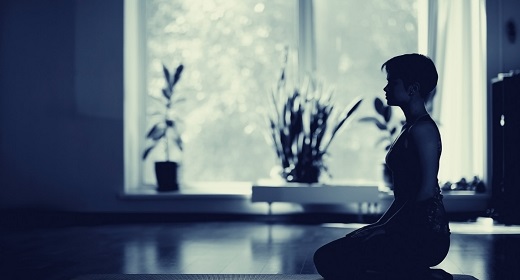by Nicole Daedone: We might just be the last people to this particular pajama party, but we recently found out that there’s an entire meditation practice that revolves around orgasms…

Nicole Daedone—the creator of Orgasmic Meditation (OM) and the founder of its rapidly growing organization, OneTaste—explains it in broad terms: OM is to sex, as yoga is to fitness. More specifically, and simply, the practice of OM looks like this: a woman lies down and her partner strokes her clitoris for 15 minutes using a learned technique. (It turns out that there are 10 primary spots on the clitoris and each one has its own particular sensation.) The goal of the practice? Experiencing more connection, happiness, vitality, and fulfillment—all possible, according to Daedone, when you have the power of Orgasm with a capital “O.” As Daedone explains below, she distinguishes the Orgasm state (a larger state of consciousness) from the conventional definition of orgasm as climax (fleeting physical pleasure). She explains more below.
A Q&A with Nicole Daedone
Q: What is the practice of Orgasmic Meditation all about?
A: It is a practice that combines the power and attention of meditation with the deeply human, deeply felt, and connected experience of orgasm.
When I first tried OM, I had a life-changing experience. It was so profound, so, “Oh! This is what is supposed to be!” that I began to investigate the question: what would happen if we rebuilt sex from the ground up, but this time, included consciousness and spirituality. The same way that we have been moving from processed to whole foods, from mere fitness to yoga, OM shifted sex out of the dark, under the covers, from the shameful and often consumptive places where it used to be, and into the light. Here we can have experiences that foster our well-being. We take the most powerful impulse, the orgasm impulse, and approach it in an entirely new way. OM offers a practice through which we can harness this impulse that is a deliberate, repeatable method for accessing the orgasm state.
“It’s that feeling of being so completely absorbed in an experience that there is no psychic chatter, no being “stuck in your head”; a falling away of the ego.”
And there’s an important distinction that’s worth making here. I differentiate between climax and the orgasm state. Climax is a few seconds of physical experience, whereas the state of orgasm is continuous—more akin to an optimal state of consciousness brought about from the activation of the sex impulse. It’s that feeling of being so completely absorbed in an experience that there is no psychic chatter, no being “stuck in your head”; a falling away of the ego. When this happens, our sense of limitations falls away as well. In the orgasm state, we feel totally present and connected, as if a deeper intuitive sense has awakened. The state occurs both in the practice of OM itself, and it has cumulative positive effects that carry over into everyday life.
Q: Why do you believe so many women are conflicted about orgasm? And why do you think it’s so difficult for so many women to achieve orgasm?
A: I’ve worked with tens of thousands of women and I’ve not once seen a woman who couldn’t access the orgasm state. I’ve met women who can’t climax in the way a man does, but I’ve never seen a woman who isn’t capable of entering the state I’m talking about. And women are conflicted because the options available to them are not the options that suit their bodies! They’re based almost entirely on a confining definition of climax. For instance, reading arousal in a woman’s body is often more challenging than in a man’s. We’re conditioned to think “orgasm” can only be present when there’s a huge peak and release of energy (with all the attendant thrashing and moaning). But a women’s arousal can be so much more subtle. You can tune into it through swelling, juices, contractions of the vaginal walls, pulsing, buzzing, tingling, and so many other sensations. Many women may have these experiences, but discount them because they don’t conform to the conventional definition we have of orgasm.
“It’s like she gets to have a sober blackout, to totally relax, and come back refreshed and with a whole new perspective.”
Not only that, but women also contend with a much higher vigilance center—you know that part of the mind that’s always on the lookout for threat or danger. To get our minds to relax, root into our bodies and simply feel, is a much more challenging task for women than for men. We’re thinking about picking up the kids, the meeting at work tomorrow, how our bodies look, and on and on. So to have a practice that allows a woman to soften and shift her attention to how she actually feels is invaluable. It’s like she gets to have a sober blackout, to totally relax, and come back refreshed and with a whole new perspective.
Q: How can we incorporate some of the tenets of OM into our sex lives?
A: There are 10 key tenets of OM that we can take into all areas of life. For instance, at OneTaste, we say, “let your desire lead.” As women, we are often taught that our desire is indulgent or selfish, but true desire is at the foundation of all great things—from relationships to innovation. It’s the only force powerful enough to pull us out of the everyday routine of life, or the muck and mire we sometimes get stuck in. I’ve always noticed that beneath every complaint is actually a desire, so we train women to go straight for speaking the desire. And you know what? Women are positively shocked to discover that their partners are dying to hear specific instruction. I had one couple come into an OM class who had given up after 17 years of a fairly challenging sex life. We did a simple exercise, “Just instruct him on what you desire, the pressure, the speed, the intensity.” At one point in the session, the husband began to cry. He said all along he had just wanted to know how to have her feel good. Desire, it turns out, is vital for human connection; and we often discover that what seems selfish is, in fact, anything but.
“The small miracle is that when we are actually there with each other fully and leave behind the toys and the feather boas or the complicated lingerie, we discover that the simple connection is what we’ve actually been craving all along.”
Another tenet is “feel over formula.” Bookshelves are overflowing with books on sex techniques, magazines are chock full of “How to Please Him in Bed” articles, and yet no one seems to be finding what they are looking for. The reason is that what they are looking for is not in the technique. What makes yoga invaluable is not just a series of postures, but the added dimension of awareness one develops. That “something extra” is what we are looking for in intimacy as well. So what we teach are processes that train people how to viscerally sense each other. An example is touching for your pleasure—showing people how to touch for the pleasure in their own hands, not entirely unlike the way that they would stroke velvet or their pets. Not to get an effect, but to be present in the pleasure in your own body and with each other. The small miracle is that when we are actually there with each other fully and leave behind the toys and the feather boas or the complicated lingerie, we discover that the simple connection is what we’ve actually been craving all along. And we can begin to extend this into our whole lives. We learn to take pleasure from the experience. Not living from a formula, but from how good something feels.
Q: Your first book is called Slow Sex. What is slow sex, and why do you believe it’s better?
A: I was super turned on to the Slow Movement when I wrote Slow Sex. The Slow philosophy is not merely about doing everything slowly, it’s about doing everything at the right speed, in their tempo giusto, or exact time. It’s about savoring experience rather than rushing through it. And, most importantly, it’s about taking the time to nourish. I often talk about the Western Woman’s Mantra: “I eat too much, I work too much, I give too much, and yet there is still this hunger that I cannot feed.” It just so happens that this hunger is only fed in the slowness of human connection—coming back to basics, reprioritizing our well-being over our “doing.”
“My wish is that our old-guard view of sex as recreational or indulgent gets replaced with the perspective that it can be used for personal and collective evolution in the most real and practical way imaginable.”
As far as being better, I have an interesting vantage point in the world. When people ask me what I do, I say, “I teach about orgasm.” Immediately following the “wow” (it usually looks like their circuits are a bit blown), they will often respond with some variation of: “ah, thanks, but my sex life is just fine,” or, “my sex life is good.” And after 20 years of practice, and after having been one of those people myself at one point, I want to say this: fine and good is not good enough. Inside your own body, you carry the most powerful drive on the planet that can be used not just to feel good but to evolve you as a human being, to incline you towards empathy, connection, and generosity both as evidenced scientifically and experientially. My wish is that our old-guard view of sex as recreational or indulgent gets replaced with the perspective that it can be used for personal and collective evolution in the most real and practical way imaginable. To use a Buddhist expression, we can turn poison into medicine. We can shift from sex as consumptive, porn-riddled, and denigrating, to a practice that heals, connects, and empowers.
Q: Is there really such a thing as a 15-minute orgasm?
A: Well, I hesitated to say four hours, because I didn’t think anyone would believe me…
I remember the first time I tried OM. My partner was stroking and nothing happened. As per usual. I was thinking this whole thing was either a very strange or very stupid idea. Or both. I had a typical range of scattered thoughts: I must be doing this wrong. I shouldn’t have eaten, my stomach is poochy. He’s kinda creepy. I wonder if we’ll get married…
Then something else broke open and I was immersed into a totally different psychological dimension. Suddenly, I started crying. I felt like something that had built up inside me—something I didn’t even know was there before—was suddenly thawing. I felt a hit of genuine empathy in that moment. Keep in mind that I had experienced universal connection in sitting meditation, but now I was experiencing it while connected to another human being. And once you have that experience everything begins to rearrange itself. Everything that blocked connection fell away and what had previously been a spotty glimpse of what was possible, was now simply on.
“Everything that blocked connection fell away and what had previously been a spotty glimpse of what was possible, was now simply on.”
It was my first visceral experience of the orgasm state. And the more I practiced Orgasmic Meditation, the more my capacity to know and understand intuitively what was happening with people, to feel them, and to actually have room for them, increased. Dramatically. I was cultivating the capacity to maintain stillness of mind in more and more intense situations, which in turn allowed for presence of mind in all situations. It was not additive growth, though; it was exponential. It became something I could feel everywhere.
Q: If you could change one thing about our common perception of orgasm and sex, what would it be?
A: To date, we have been squandering one of our most powerful resources: the sex impulse. We have been using it, haphazardly, recreationally, to blow off steam when, if channeled correctly, it could be used to light up the entire power grid of connection. Orgasm—capital “O”—is so, so much more than the brief, fleeting climax we have been taught to think of it as. When we harness our sexual energy, we change the whole of our lives and become more empathetic, connected, loving human beings.
“We have been using sex, haphazardly, recreationally, to blow off steam when, if channeled correctly, it could be used to light up the entire power grid of connection.”
I want people to truly understand that how you get where you are going profoundly affects what you get when you arrive. We have not been taught simple ways to access what we are looking for that contribute to our overall well-being, restore pleasure, and in the process make us better human beings. Orgasm has a big promise: union. Tibetan Buddhists use it as a metaphor for enlightenment, and yet we have not seen it deliver. Until now.
Q: You’ve said that orgasm has the ability to increase our bandwidth for connection and attention. How does this extend outside of the bedroom, and is there science behind it?
A: OM changes the way we respond to sensation; it changes our brain. It strengthens the parasympathetic nervous system (“rest and digest”) as opposed to the sympathetic nervous system (“fight or flight”). And it affects our metabolism, heart rate, blood pressure, respiration, and brain chemistry, and brings about a state of extended deep relaxation. Similar to other mindfulness practices like meditation and yoga, these changes make it possible to develop attention and access flow states—the ability to be “in the zone.” (Recent research in Los Angeles and Philadelphia found that just three months of OM can help put you into the same alpha brain state as three years of transcendental meditative practice!)
OM also shifts our center of intelligence from the cortex system to the limbic system—which allows us to feel things like intimacy and empathy, and which has a flexible capacity—expanding our appetite for connection.
“There are two scenarios in which a woman’s body really pumps out oxytocin (which is often called the bonding hormone): childbirth and orgasm.”
Maybe most significantly, OM bolsters the “happy hormones”—like oxytocin, dopamine, and prolactin—that are known to make us feel good (minus the less sweet side effects of medication). Oxytocin, in particular, plays an important role when it comes to how we bond with others. Symptoms of low levels of oxytocin include everything from poor social involvement to low libido, sleep disturbances, weight gain, and depression—and low oxytocin seems to be playing a big part in the breakdown of human connection. Friends who are scientists have suggested to me that female orgasm may actually exist solely for the purpose of human connection. There are two scenarios in which a woman’s body really pumps out oxytocin (which is often called the bonding hormone): childbirth and orgasm. In terms of biological evolution, it may just be that we need oxytocin in order to keep us bonded to one another, to keep our culture together.
Q: We heard you were once going to be a nun…
A: It often surprises people that on my way to becoming a Buddhist, I discovered this practice. In actuality, both are about developing consciousness and connection. Now they just call me “the nun that gets some.”
—–
Daedone has studied Zen Buddhism, mystical Judaism, and semantics, and the practice of OM combines distinctive elements of her diverse background and expertise in surprising but thoughtful ways. Her company, OneTaste, has a presence in 30 cities around the globe, with tens of thousands of participants. Daedone is also the author of Slow Sex: The Art and Craft of the Female Orgasm. Check out her SXSW talk that explains how Orgasm and the internet share a common purpose. (Yes, you read that correctly.)
This Simple Breathing Trick Can Give You Better Orgasms
The Mystery Of The Female Orgasm
This Is The Main Reason Humans Crave Orgasms
















































